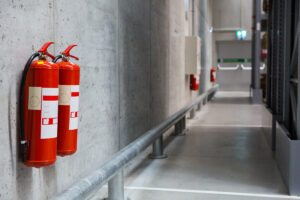
Every industrial facility needs to take fire safety compliance to ensure the safety of its property and its workers.
Fire safety compliance is not just about meeting legal requirements—it’s about protecting your employees, property, and the community. Industrial facilities, with their unique risks, must go the extra mile to prevent fire hazards. Whether you’re updating your facility’s compliance measures or preparing for an inspection, this guide will walk you through the essentials of fire safety preparedness.
Understand Fire Safety Regulations
Industrial facilities must adhere to local, state, and federal fire codes. In the U.S., these are often dictated by standards from the Occupational Safety and Health Administration (OSHA) and the National Fire Protection Association (NFPA). Some of the most applicable codes include:
- NFPA 1 (Fire Code): A comprehensive guide to fire prevention and building safety.
- NFPA 101 (Life Safety Code): Focuses on safety for occupants during a fire.
- NFPA 30: Covers flammable and combustible liquid storage.
Ensure that your industrial facility meets these fire safety compliance standards and that you’re regularly updated on code changes. Local fire departments or consultants can help clarify specific regulations that apply to your business.
Conduct a Fire Risk Assessment
Every industrial facility faces unique fire hazards based on its operations, materials, and processes. Conducting a fire risk assessment helps you identify these hazards and prioritize mitigation strategies.
- Inspect flammable materials: Evaluate the storage and handling of flammable liquids, gases, and solids.
- Evaluate equipment: Look for overheating machinery, faulty wiring, and inadequate maintenance.
- Assess escape routes: Ensure all emergency exits are clearly marked, accessible, and unblocked.
A professional fire safety consultant can help identify risks you may overlook and provide actionable recommendations.
Install and Maintain Fire Safety Equipment
Industrial facilities often require specialized fire safety systems due to the scale of their operations and the materials they handle. Key equipment includes:
- Fire extinguishers: Ensure the correct type (e.g., Class A, B, C, D, or K) is placed strategically throughout the facility.
- Sprinkler systems: Test your sprinklers regularly to confirm functionality.
- Smoke detectors and fire alarms: These systems must be tested, maintained, and audible throughout the facility.
- Emergency lighting: Ensure adequate backup lighting is available for safe evacuation.
Regular inspections and maintenance of this equipment are critical. Schedule routine check-ups and keep a record of maintenance activities for compliance purposes.
Train Employees on Fire Safety
Employees are your first line of defense during an emergency. Comprehensive training ensures everyone knows how to respond effectively.
- Fire drills: Schedule regular drills to practice evacuation procedures.
- Fire extinguisher training: Teach employees how to operate fire extinguishers properly.
- Emergency response roles: Assign roles such as fire wardens, who will guide others during evacuations.
- Hazard awareness: Educate employees about specific fire hazards in your facility and how to mitigate them.
Training sessions should be refreshed periodically to ensure employees remain prepared and confident.
Create a Fire Safety Plan
A written fire safety plan is not just a regulatory requirement—it’s a vital tool in an emergency. The plan should include:
- Evacuation routes and assembly points.
- Procedures for shutting down critical equipment during a fire.
- Contact information for emergency services and key personnel.
- Steps for reporting and containing small fires (if safe to do so).
An industrial facility should share this plan with all employees and post key information, such as evacuation maps, in visible locations.
Schedule Regular Inspections
Fire safety compliance isn’t a one-time achievement—it’s an ongoing commitment. Regular inspections help identify new risks and ensure that your facility remains up to code.
- Schedule annual fire department inspections to verify compliance with local codes.
- Conduct internal audits of fire safety systems and procedures.
- Review inspection findings and act immediately to resolve issues.
Keeping up with inspections minimizes risks and avoids costly fines or shutdowns.
Partner with Fire Safety Experts
Fire safety is a complex and technical field. Partnering with professionals ensures that your facility meets and exceeds compliance requirements. Fire safety experts can:
- Conduct detailed fire risk assessments.
- Help design and install fire suppression systems.
- Provide tailored employee training.
Additionally, these experts stay updated on changing fire codes and can guide you through compliance effortlessly.
Fire Protection Services from Fireline
Whether you need smoke detectors, fire extinguishers, or an automatic sprinkler system installed at your commercial property, Fireline has you covered. We have been protecting people and property from fire damage since 1947—and our experience shows in our excellent work! We are known for our superb customer service, our expertise, and our reliability. For more information on how we can help your residential or commercial property, visit us online or give us a call at (800) 553-3405. We are in Baltimore, MD, with a second office in Leesburg, VA. For more fire safety tips, be sure to follow us on Facebook, Twitter, and LinkedIn.
